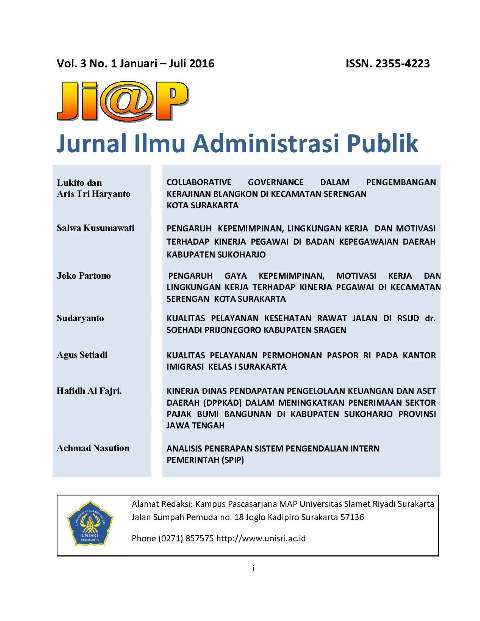COLLABORATIVE GOVERNANCE DALAM PENGEMBANGAN KERAJINAN BLANGKON DI KECAMATAN SERENGAN KOTA SURAKARTA
DOI:
https://doi.org/10.33061/jp.v3i1.1195Abstract
This research aimed to study factors succeeding as well as inhibating
collaborative governance in developing blankon handicraft. The research
employed seven indicators to measure the degree of success and of failures
affecting collaborative government. 1) Network structure; 2) Comitment to
common purpose; 3) Trust among the participants; 4) Access to authority; 5)
Distributive accountability/responsibility; 6) Information sharing; and 7) Access
to resource. Qualitative research approach was used in this study. Research
result showed that the implementation of collaborative governance in
developing blankon handicraft was not optimally obtained due to: a)
Collaborative government was not decided under the letter of memorandum of
understanding. b) In implementing collaborative governance the commitment of
authority depended on each stakeholder. Thus, there was no clear network
structure. The seven indicators employed for analysing collaborative
governance research result showed that: 1) Network structure had already
worked, however, it did not optimally work due to that there was no decision
under the memorandum of understanding. 2) Commitment to common purpose
among the stakeholders had already agreed among the stakeholers, however, it
was only coordinative in nature. That is why, the common commitment can be
denied; 3) Trust among the participant. There was no full trust among the
participants; they are duobtful. 4) Access to authority done according the
existing authority and according to each task; 5) Distributive accountability or
ability to respond did not happen among related institutions, but it depended
upon each institution and each did not influence among others; 6) information
sharing has already worked; information was easily accessable; 7) Access to
resource only worked for the governmental and corporate instituions since they
had enough resources, but on the other hand the stakeholder, i.e. the
handicrafters and their assiciations did not have enough resources.
Key words: Collaborative governance, Network structure; Commitment to common
purpose; Trust among the participants; Governance; Access to authority;
Distributive accountability/responsibility; Information sharing; Access to
resource.
Downloads
Published
How to Cite
Issue
Section
License
Authors who publish this journal agree to the following terms:
- Authors retain copyright and grant the journal right of first publication with the work simultaneously licensed under a Creative Commons Attribution License that allows others to share the work with an acknowledgement of the work's authorship and initial publication in this journal.
- Authors can separately make additional contractual arrangements for non-exclusive distribution published by the journal (e.g., publish it in a book), with an acknowledgement of its initial publication in this journal.
- Authors are allowed and encouraged to send their work via online (e.g., in the institutional repositories or their website) after published by the journal.













